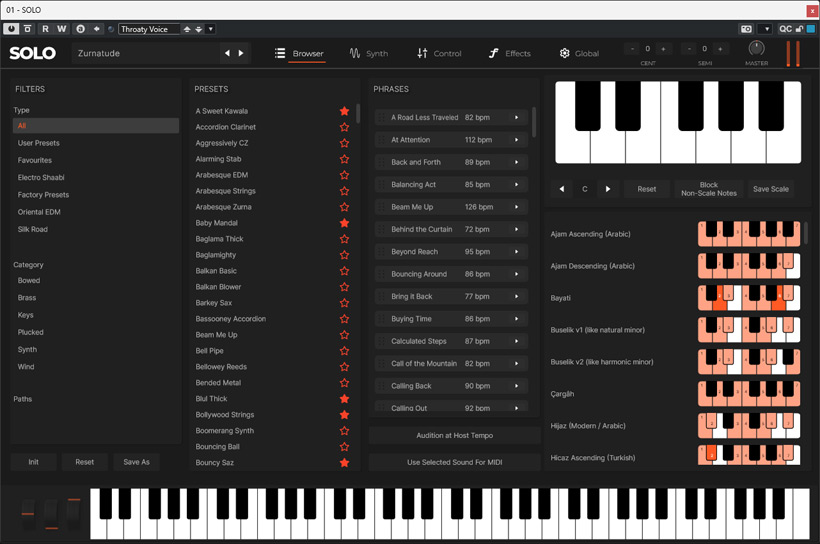TAQS.IM SOLO and MicroToner
Author: Peter Kaminski

TAQS.IM is a USA-based company dedicated to creating authentic world sounds for musicians worldwide. Inspired by global musical traditions, TAQS.IM provides virtual instruments and mobile apps that capture the essence of diverse cultures.
Even as a teenager, I was very interested in oriental music and studied it intensively. So I couldn't resist testing and presenting SOLO, and I have to say that the effort was worth it.
Requirements and installation
SOLO is available as a stand-alone software for macOS and Windows, as well as a plug-in in VST3, AAX, and AU formats. VST2 is not available, but that format is being phased out anyway. Before installation, you have to create a user account at TAQS.IM and install the “taqs.im HUB” software.

After starting, you first have to establish a connection to the user account. This is best done by logging in using a web browser.

You only have to enter the data once and then start the taqs.im HUB management software.

Now you can install the software and the expansion packs.
SOLO
After starting the stand-alone software or the plug-in, a bar at the top of the screen allows you to select a preset, fine-tune the pitch, and adjust the output level.
![]()
Here, you can also switch between the five different pages. Let’s first look at the page with the global settings.
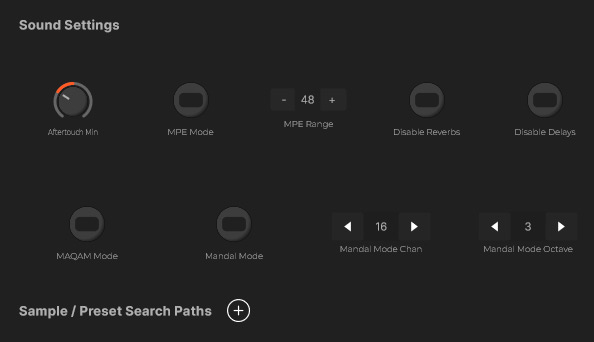
Here, you can deactivate effects, activate the MPE mode, and set the MPE range. The “MAQAM Mode” is used to activate compatibility with the MAQAM Quarter Tone Tuning Controller from Mazeka Toys. But that’s something special for users from the Arab world. The Mandal Mode can be used to switch the microtuning per note. The switch is made with the keys in the specified octave.
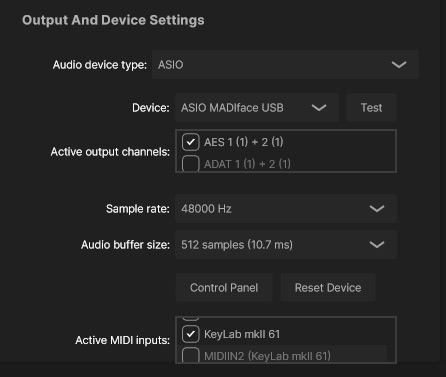
In the stand-alone version, an additional area appears where you can select the audio interface and the desired MIDI device. ASIO interfaces can also be used here.
Presets and Scales
Next, we would like to introduce the browser section, which is used to manage presets. The presets can also be marked as favorites, and it is possible to select them by tonal or instrumental categories or to list them by expansion packs or favorites.
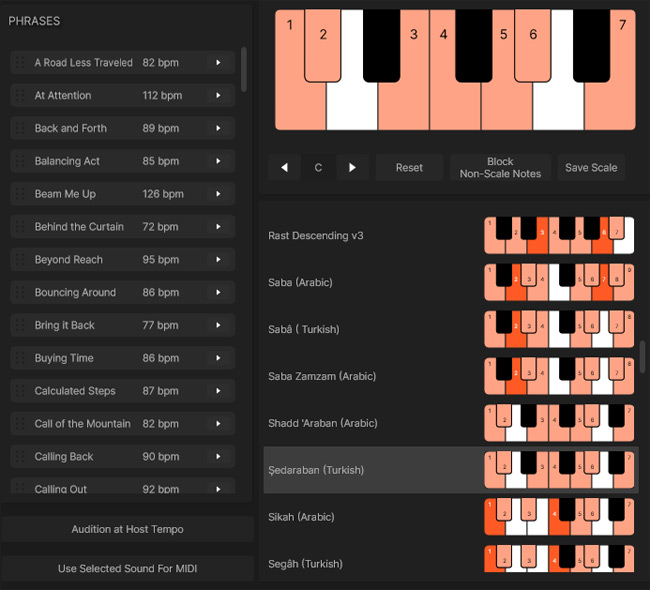
Here, you can also create and manage scales and select an active one. Typical phrases can also be called up. These are usually played with a stored tempo and an assigned preset. However, you can also use the set tempo in the host software and the selected preset to play them. These functions can be activated using the two buttons below the list of phrases.
Synth
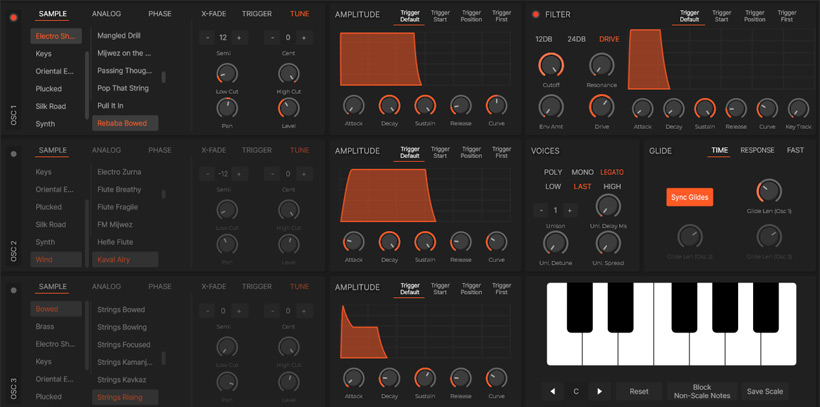
The synthesizer offers three oscillators. Behind each is a virtual VCA with an envelope generator, and the sum then goes to a filter with its own envelope generator.

In addition to samples, classic waveforms and noise can also be used as a source - and proportions can be mixed here (see figure below).

SOLO also offers phase distortion synthesis in the oscillator section (see figure below).

The filter slope can be switched between 12 and 24 dB/oct.
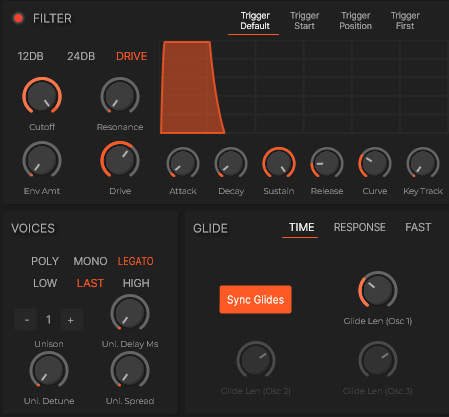
Below the filter, you can select the keyboard operating modes and parameters for unison operation (number of voices, detune and spread). Glide when keys are changed can also be activated and extensively adjusted.
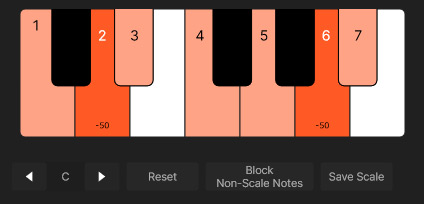
The currently selected scale can also be seen on the Synth page. Adjustments can also be made her: For example, the root note and notes that are not available in the selected scale can be blocked.
Control
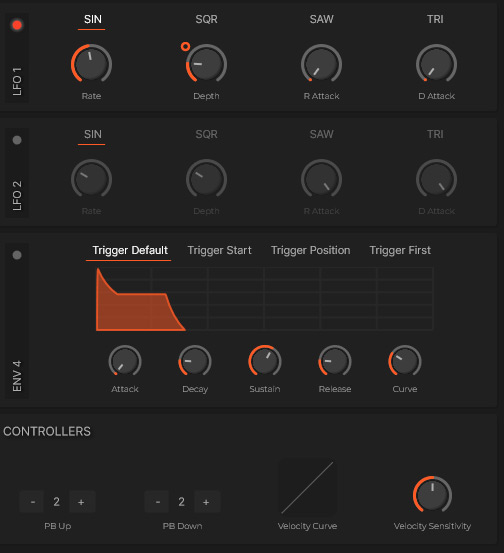
The Control page offers the option to adjust the modulation sources.
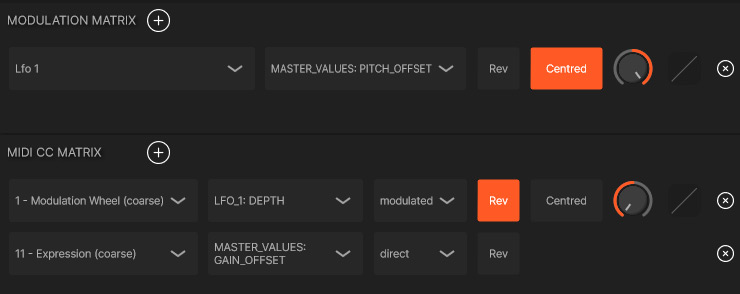
The sources can be switched to the targets via the modulation matrix (see figure above).
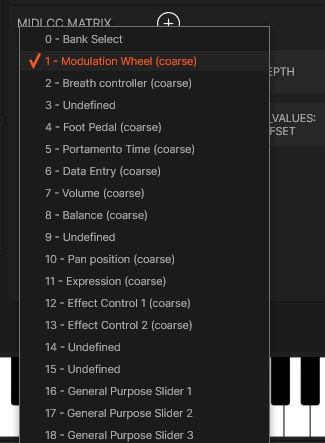
The influence of MIDI controllers on the modulation parameters can also be defined in the lower area.
Effects
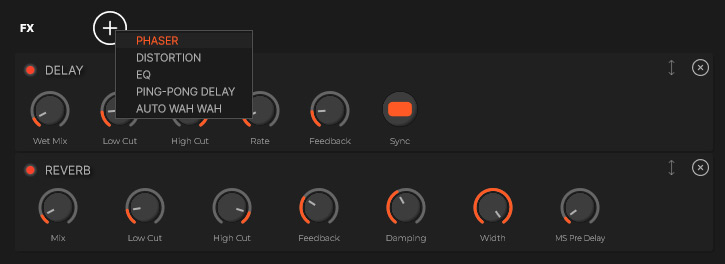
The effect section offers seven different effects: equalizer, distortion, auto wah, phaser, delay, ping-pong delay, and reverb.
MicroToner
If you now want to use the different scales with microtones with the SOLO, the question quickly arises how to deal with virtual instruments that cannot use microtones, which results in the pitch not always being correct when playing together. TAQS.IM also offers a solution for this in the form of software or plug-ins. We would like to explain how to work with the plug-in when using Steinberg's Cubase or Nuendo. The process is similar when using Pro Tools, Studio One and FL Studio.
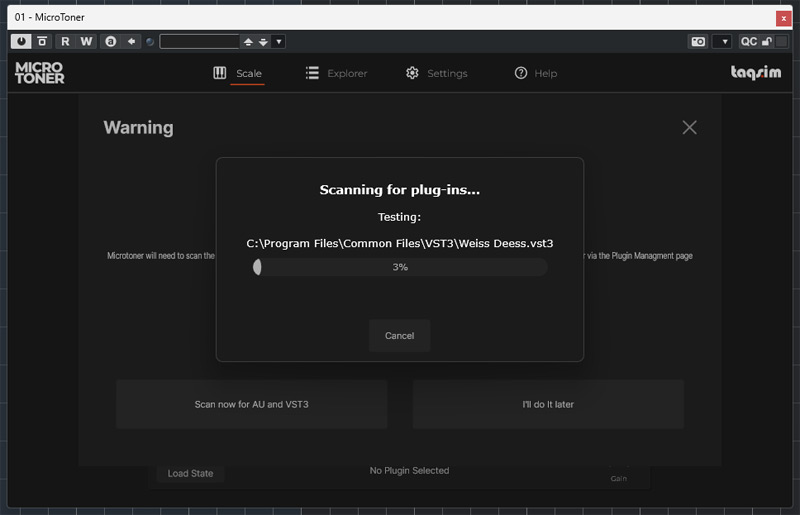
MicroToner is a plug-in that is integrated as a virtual instrument in the corresponding MIDI track via the VST instrument selection. After the first call, you have to scan the available virtual instruments (see figure above). Now you can call up the desired VST instrument within the plug-in and then make the corresponding settings in MicroToner concerning the scale.
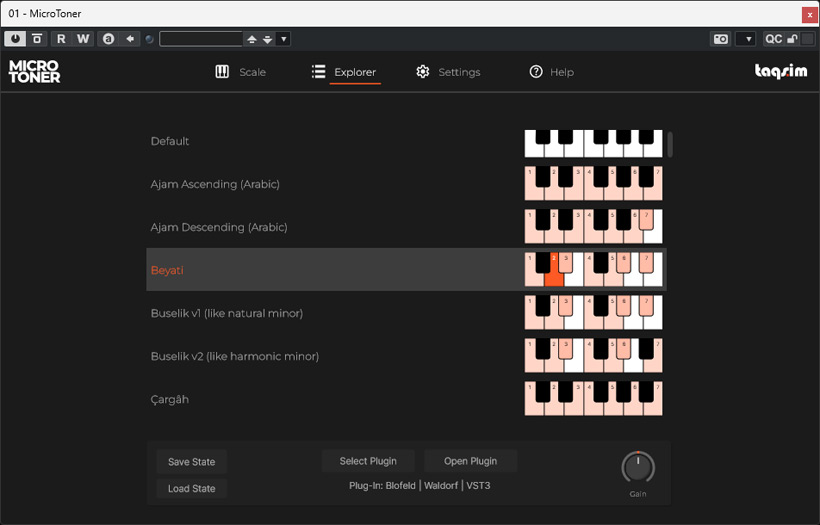
The “Explorer” page allows you to select a scale.
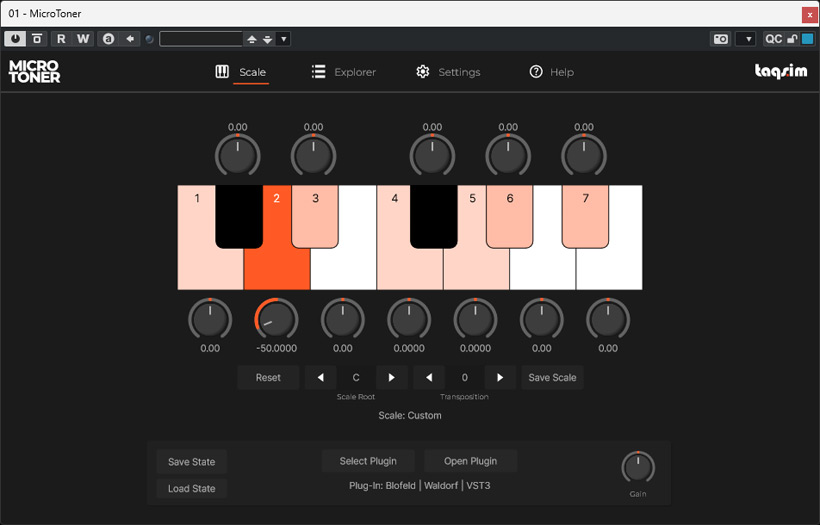
The “Scale” page allows you to customize the scale for each key.
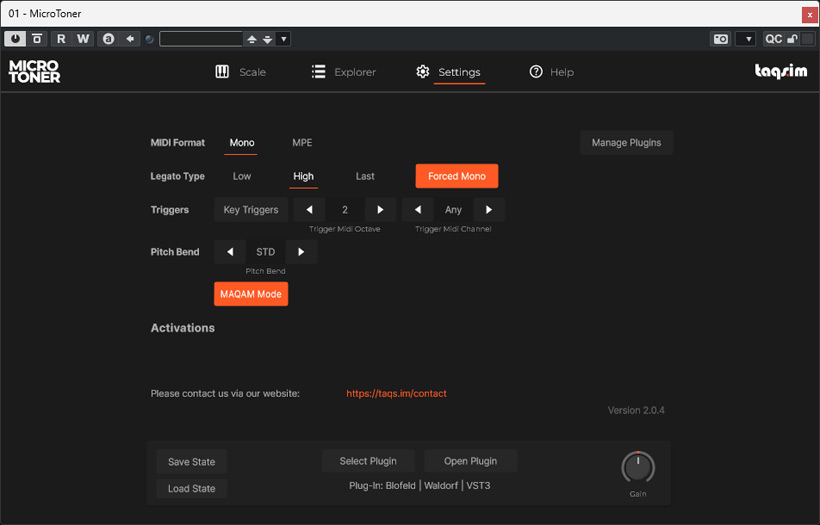
The MIDI parameters can be set on the “Settings” page. The pitch adjustment is done via MIDI pitch bend messages. By default, the pitch bend range is set to +/- a semitone (STD). Of course, this must also be set accordingly on the synthesizer.
An MPE mode can also be activated for the MicroToner plug-in. The “Help” page provides a summary of the most important things, as well as access to the online manual.
For host software applications where integration is not possible in this way, such as Logic Pro, Ableton Live, or Reaper, there is an effect plug-in, called the “MicroToner MIDI Effect Plug-In”. But that’s not everything. A stand-alone software is also provided that works just like the MicroToner plug-in and thus represents a separate host software. Here, you can also select the MIDI receive port, MIDI channel, audio driver (including ASIO), and the desired outputs.
Practice
We tested under Windows 11 on a B14 AudioKern workstation from Digital Audio Service, to be specific, the SOLO version 3.3 (a few pictures in the review are version 3.2 based) and the MicroToner version 2.0.5. We tested the plug-ins under Nuendo 13.0.51 as host software. The installation of the software and plug-ins went smoothly. It was only necessary to log in a second time. After that, the login to taqs.im HUB worked perfectly. The manuals are only available as online content in English, and there are no PDFs.
The SOLO version 3.3 was released during the test period and now offers: velocity-controllable filters, velocity control for each oscillator, dynamic envelopes, improved MPE support, preset and phrase search fields, improved breath controller support, the graphical display of the GUI has been slightly optimized, project loading times have been accelerated and the factory presets have been partially revised and new presets have been added. And of course, there have been bug fixes.
However, very often you don’t have to look at the manual. Once you understand the principles of SOLO and the MicroToner, the rest is self-explanatory for experienced users, with a few exception. No problems did arise during operation either. It is noticeable that the size of the user interface can be adjusted with the mouse in the stand-alone software, but not in the VST3 plug-in under Nuendo.

Of course, the SOLO synthesizer appeals to Asian-influenced musicians, but in terms of sound, SOLO is also definitely interesting for users in the fields of film music, ambient music, and also EDM, where Asian sounds are often used. The many different flute-like instruments, such as the ney with its interesting blowing timbres, sound particularly great. The different variants of the fretless short-necked lute Ud are also great. They are very easy to play on the keyboard. The sitar presets sound great too. The presets with the Turkish saz, or balagma, sound a bit synthetic, like the original with electric pickups. I would have liked to see more acoustic-sounding variants here, but such synthetic sounds are very popular in the Orient. Also, the dulcimer-like instruments such as santur or kanun (similar to a European zither) enrich the sonic portfolio of SOLO.
We also tried out the three expansion packs. With “Electro Shaabi” and “Oriental EDM”, the sonic imprint should be clear from the name. But I liked “Silk Road” best, and I marked many favorites right away. You should plan for the expansion as an option right away. Incidentally, about 250 presets come with SOLO. Each expansion pack offers another 50 presets.
But oriental music not only lives from its sounds but also from its scales, which are typical composed of micro-tone intervals. There are many of them, and they vary from region to region. The ones available in SOLO are a comprehensive base with an excellent selection. It is worth experimenting with them. Unfortunately, the phrases cannot be triggered with a key, but there is a pre-liste feature with a mouse click. You can import the MIDI events of the phrases with a drag & drop from the plug-in on to a MIDI track. This works perfectly in Nuendo.
The MicroToner software is also highly recommended and can be used to apply the various scales to other virtual instruments in regular music software applications. The 2.05 update fixes a number of bugs and this version is realy stable.
What is missing from MicroToner is the ability to deactivate keys for notes that are not used in a scale. As mentioned before, the pitch correction is done via MIDI pitch bend. This does not work perfectly with every synthesizer. Some virtual instruments react to the extremely fast pitch bend correction with a more or less pronounced glide or a type of modulation. You just have to try it out. However, for many of them, this works perfectly after adjusting the pitch bend range in the instrument. It should be emphasized again that the stand-alone version also comes with host software. So if you want to use or play VST instruments on a laptop without using a music recording software like Cubase, you can do so with the MicroToner stand-alone software.
SOLO Update 4.0
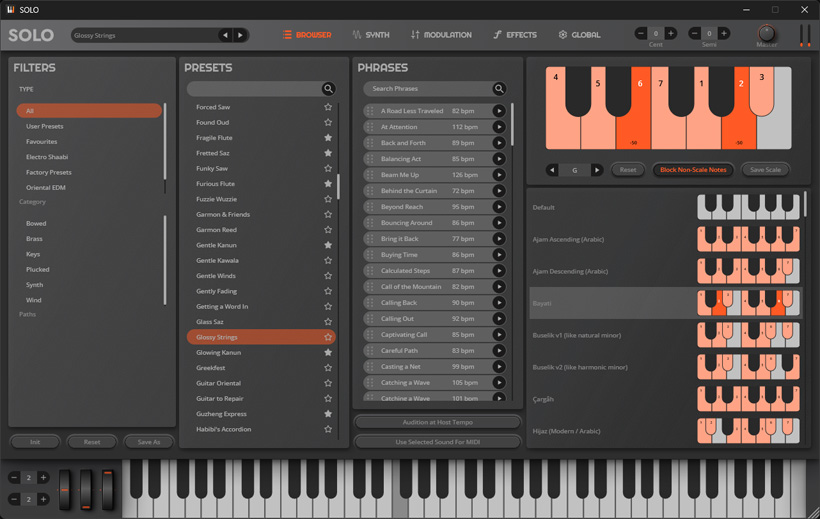
Version 4.0 of SOLO has been available since October 2025. It offers a redesigned user interface, an improved sound engine, a new wavetable oscillator, and all presets have been adapted to the new possibilities. Processor utilization has also been further optimized.
Conclusion
The regular price for the synthesizer Solo is 149 US$, and for the MicroToner 49 US$. The three expansion packs cost 49 US$. Bundles are also available. Here, you should check out the current offers on the website. Solo can be purchased through the manufacturer’s website.
SOLO offers a truly amazing sound library with a full range of oriental instruments and sounds. For those who want to use non-European scales or experiment with microtones, the software or plug-in MicroToner is recommended, even though it doesn’t work with all instruments without conditions. A must for users of microtones.
 How to resolve AdBlock issue?
How to resolve AdBlock issue? 